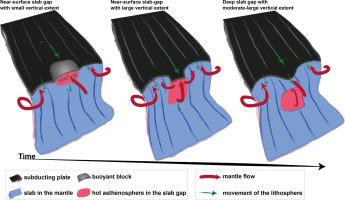当前位置:
X-MOL 学术
›
Tectonophysics
›
论文详情
Our official English website, www.x-mol.net, welcomes your
feedback! (Note: you will need to create a separate account there.)
The effect of slab gaps on subduction dynamics and mantle upwelling
Tectonophysics ( IF 2.7 ) Pub Date : 2020-06-01 , DOI: 10.1016/j.tecto.2020.228458 Ágnes Király , Daniel E. Portner , Kirstie L. Haynie , Benjamin H. Chilson-Parks , Tithi Ghosh , Margarete Jadamec , Anna Makushkina , Michael Manga , Louis Moresi , Keely A. O'Farrell
Tectonophysics ( IF 2.7 ) Pub Date : 2020-06-01 , DOI: 10.1016/j.tecto.2020.228458 Ágnes Király , Daniel E. Portner , Kirstie L. Haynie , Benjamin H. Chilson-Parks , Tithi Ghosh , Margarete Jadamec , Anna Makushkina , Michael Manga , Louis Moresi , Keely A. O'Farrell

|
Abstract Gaps within a subducting plate can alter the surrounding mantle flow field and the overall subduction zone dynamics by allowing hot sub-slab mantle to flow through the gaps and into the mantle wedge. This through-slab flow can produce melting of the slab gap edges as well as significant upwelling that can lead to anomalous alkaline volcanism and/or dynamic uplift in the overriding plate, while the altered mantle flow patterns affect the trench evolution. Numerous geodynamic models have investigated the processes that form slab gaps, but few studies have examined the dynamics of slab gap-altered mantle flow, its effects on trench morphology and kinematics, or the controlling parameters on these processes. Here, laboratory subduction models with a pre-cut gap in a subducting silicone plate are used to explore how slab gap size, and slab gap depth influence the surrounding mantle flow field and trench dynamics. Results suggest that both the vertical extent and the depth of the top (trailing edge) of the slab gap are crucial parameters for modulating overall subduction dynamics. They show that a slab gap, which occurs near the surface and initially comprises 30% of the subducting plate width, can extend enough vertically in the slab to produce significant vertical flow through the gap. Changes to the trench geometry and kinematics are also evident in the models, such that double- and triple-arc geometries are formed during subduction of a shallow slab gap. All of these results are consistent with observations of slab gaps and their induced surface expressions, or the lack thereof, in Eastern Anatolia, East Java, Italy, and Argentina.
中文翻译:

板块间隙对俯冲动力学和地幔上涌的影响
摘要 俯冲板块内的间隙可以通过允许热的亚板片地幔流过间隙并进入地幔楔来改变周围地幔流场和整个俯冲带的动力学。这种贯穿板块的流动会导致板块间隙边缘的熔化以及显着的上升流,从而导致上覆板块中的异常碱性火山活动和/或动态隆升,而改变的地幔流动模式会影响海沟的演化。许多地球动力学模型研究了形成板片间隙的过程,但很少有研究研究板片间隙改变地幔流动的动力学,它对沟槽形态和运动学的影响,或对这些过程的控制参数。在这里,在俯冲硅胶板上带有预切间隙的实验室俯冲模型用于探索板坯间隙大小,和板片间隙深度影响周围地幔流场和海沟动力学。结果表明,板片间隙顶部(后缘)的垂直范围和深度都是调节整体俯冲动力学的关键参数。他们表明,板片间隙出现在地表附近,最初占俯冲板块宽度的 30%,可以在板片中垂直延伸足够多,从而产生通过间隙的显着垂直流动。模型中沟槽几何形状和运动学的变化也很明显,因此在浅板间隙俯冲过程中形成了双弧和三弧几何。所有这些结果都与在东安纳托利亚、东爪哇、意大利和阿根廷对板间隙及其诱发的表面表现或缺乏这些表现的观察结果一致。
更新日期:2020-06-01
中文翻译:

板块间隙对俯冲动力学和地幔上涌的影响
摘要 俯冲板块内的间隙可以通过允许热的亚板片地幔流过间隙并进入地幔楔来改变周围地幔流场和整个俯冲带的动力学。这种贯穿板块的流动会导致板块间隙边缘的熔化以及显着的上升流,从而导致上覆板块中的异常碱性火山活动和/或动态隆升,而改变的地幔流动模式会影响海沟的演化。许多地球动力学模型研究了形成板片间隙的过程,但很少有研究研究板片间隙改变地幔流动的动力学,它对沟槽形态和运动学的影响,或对这些过程的控制参数。在这里,在俯冲硅胶板上带有预切间隙的实验室俯冲模型用于探索板坯间隙大小,和板片间隙深度影响周围地幔流场和海沟动力学。结果表明,板片间隙顶部(后缘)的垂直范围和深度都是调节整体俯冲动力学的关键参数。他们表明,板片间隙出现在地表附近,最初占俯冲板块宽度的 30%,可以在板片中垂直延伸足够多,从而产生通过间隙的显着垂直流动。模型中沟槽几何形状和运动学的变化也很明显,因此在浅板间隙俯冲过程中形成了双弧和三弧几何。所有这些结果都与在东安纳托利亚、东爪哇、意大利和阿根廷对板间隙及其诱发的表面表现或缺乏这些表现的观察结果一致。











































 京公网安备 11010802027423号
京公网安备 11010802027423号